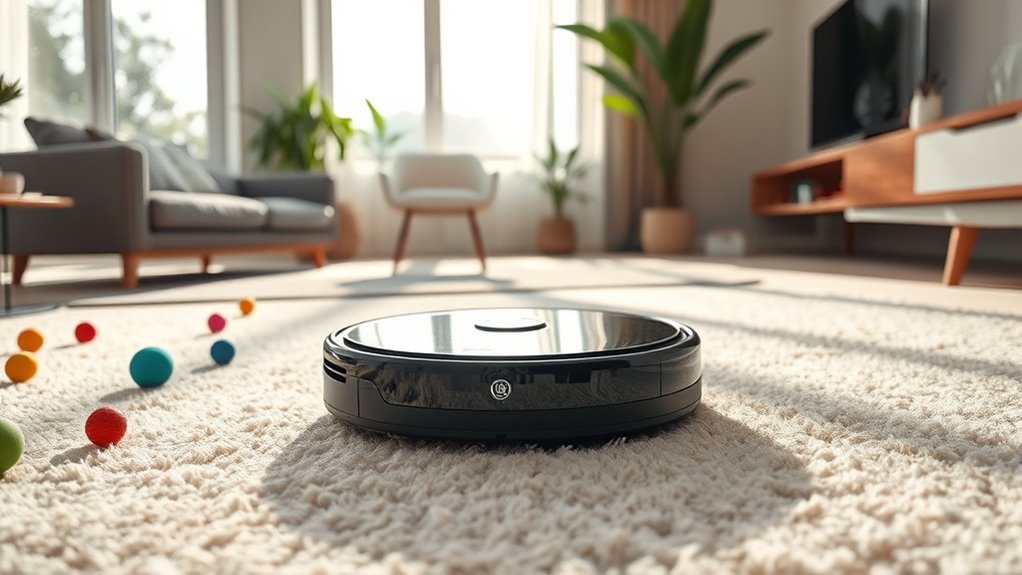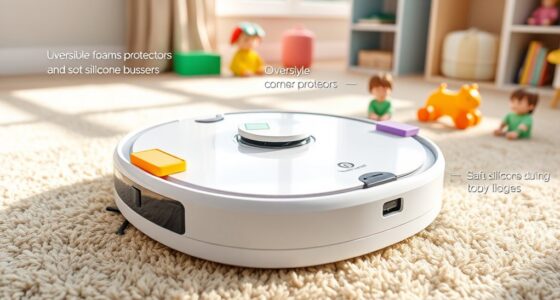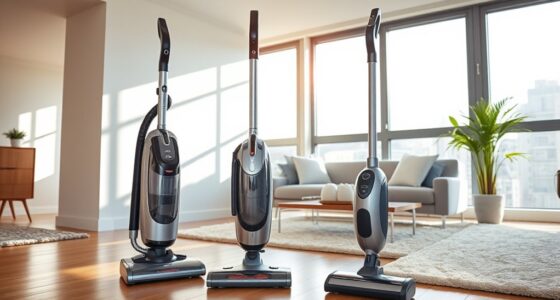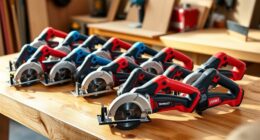Robot vacuums are transforming household cleaning, making daily upkeep easier and more convenient. They handle routine tasks on hard floors and small debris well but still struggle with deep cleaning, stubborn dirt, and complex surfaces. While technology continues to advance, they won’t fully replace manual cleaning anytime soon, especially for detailed or heavy-duty jobs. If you want to discover how these devices will shape your cleaning habits and what the future holds, keep exploring.
Key Takeaways
- Robotic vacuums excel at routine cleaning but struggle with deep cleaning tasks like corners, edges, and heavy dirt.
- Limitations in navigation and suction power prevent robots from fully replacing manual cleaning for complex surfaces.
- Manual cleaning remains essential for tasks involving stairs, upholstery, and stubborn or embedded dirt.
- Technological advancements improve efficiency but current robots cannot fully automate all cleaning needs.
- Robotic vacuums are a complement to, not a complete substitute for, manual cleaning in most households.
The Rise of Robotic Vacuums in Household Cleaning
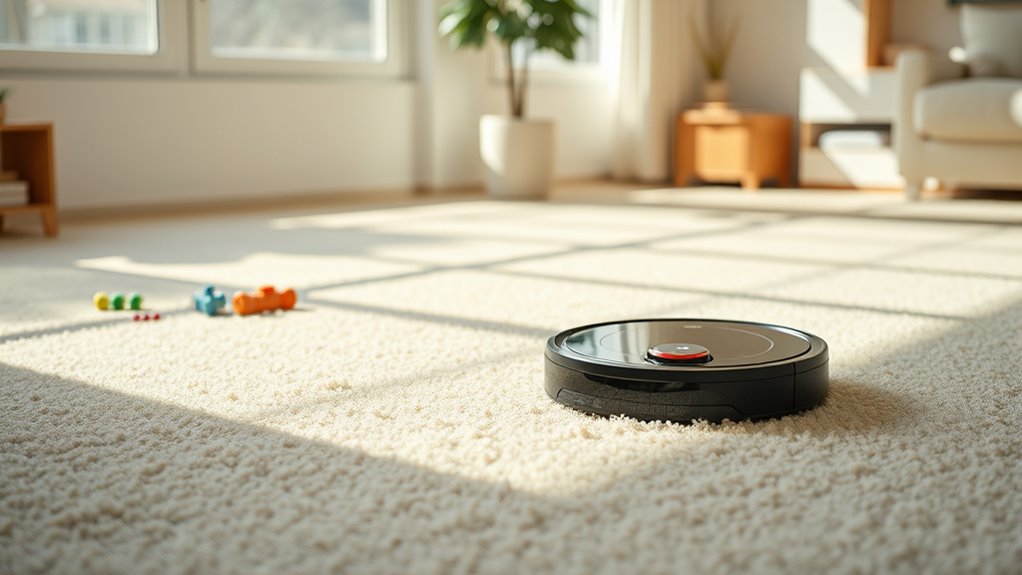
The rise of robotic vacuums has revolutionized household cleaning by making it more convenient and efficient. The global market is valued at around $5.67 billion in 2024 and is expected to grow to $6.26 billion in 2025. In the U.S., robotic vacuums are the fastest-growing segment, with a 10.6% CAGR projected through 2030. The worldwide market could reach $11.14 billion by 2025, driven by technological advances and consumer demand. More homeowners are embracing automation due to its convenience, especially in urban areas with smaller living spaces. Nearly 25% of new vacuum sales were robotic models by 2020, a figure that continues to rise. Aging populations and smart home integration further boost demand. Advances in Kia Tuning technology and design are making robotic vacuums more versatile and adaptable to various home environments. As awareness and affordability increase, robotic vacuums are moving from niche devices to mainstream essentials, transforming how we clean our homes.
Technological Innovations Driving Automation
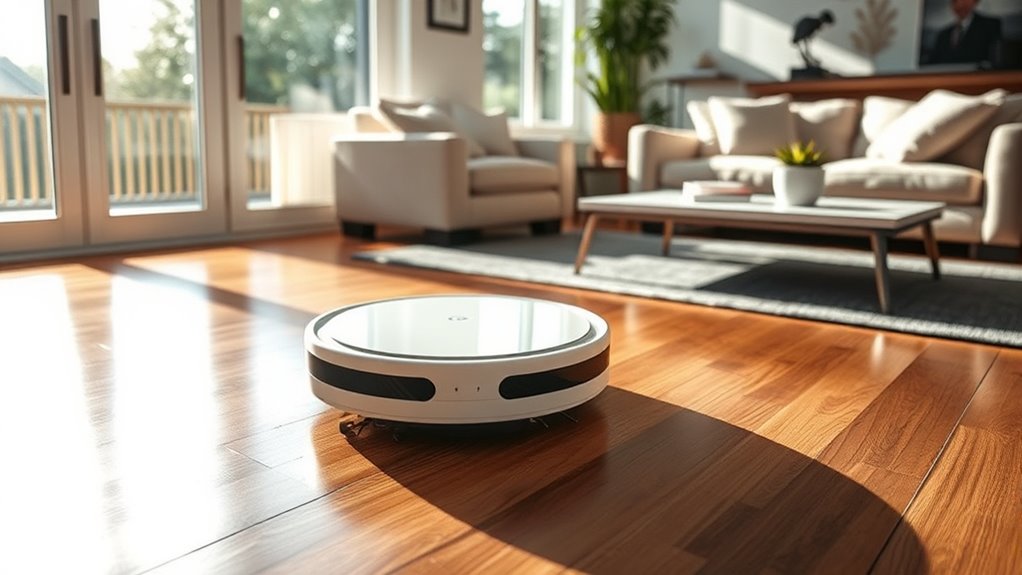
Technological innovations are transforming robot vacuums into smarter, more autonomous devices. Advanced navigation systems, like LiDAR and cameras, help them map and avoid obstacles with precision, while AI enables adaptive cleaning based on your home’s layout. Connectivity features allow you to control and schedule cleaning remotely, making automation more seamless than ever. Additionally, GMC tuning techniques inspire similar advancements in robotics, leading to smarter and more efficient cleaning solutions.
Advanced Navigation Systems
Advanced navigation systems are the driving force behind the efficiency and reliability of modern robot vacuums. They use technologies like LiDAR, SLAM, and multi-sensor fusion to create accurate maps and plan optimized routes. LiDAR emits laser beams to build a 360-degree environment map, but taller sensors can limit access under low furniture. SLAM combines data from multiple sensors to improve accuracy and adapt to changes, supporting multi-floor mapping. Multi-sensor fusion integrates cameras, infrared, and laser data for better obstacle detection, especially in complex layouts. These systems enable smarter cleaning patterns, virtual boundaries, and quicker coverage, reducing missed spots. However, reflective surfaces and soft obstacles may still cause navigation issues. Sensors act as the “eyes” of the robot vacuum, detecting obstacles and edges. They often incorporate obstacle avoidance technology to enhance their navigation. Below is a summary of key systems:
| Technology | Strengths | Limitations |
|---|---|---|
| LiDAR-Based | Fast, precise mapping, real-time updates | Tall design, struggles with mirrors |
| SLAM | Multi-sensor, adaptive, multi-floor mapping | Complex setup, sensitive to environment |
| Multi-Sensor Fusions | Combines multiple data types for accuracy | Higher cost, dependent on lighting |
AI and Sensor Integration
AI and sensor integration are transforming robot vacuum navigation by enabling smarter, more adaptive cleaning. You benefit from AI algorithms that process data from cameras, infrared, and sonar sensors, allowing your vacuum to perceive obstacles and map your home in real time. Machine learning helps it create accurate layouts, avoid furniture, and optimize routes based on past cleaning sessions. It adjusts suction power and mop modes dynamically for different floor types and dirt levels, saving time and battery. Multi-sensor fusion, combining LiDAR, IMUs, and ToF sensors, enhances accuracy and obstacle detection, reducing collisions and missed spots. Environmental sensors detect surface types, switching modes automatically. These technologies work together seamlessly to improve efficiency and cleaning quality. This integration guarantees your vacuum cleans efficiently, adapts to changes, and minimizes manual intervention, making your cleaning routine smarter and more effective. Additionally, advancements in sensor accuracy continue to refine navigation precision, ensuring comprehensive coverage of your space.
Connectivity and Smart Features
Connectivity and smart features have revolutionized how you control and customize your robot vacuum. With Wi-Fi and smartphone app connectivity, you can easily schedule cleanings, adjust modes, and monitor your vacuum’s status in real-time. Voice assistants like Alexa and Google Assistant let you control your device hands-free, adding convenience. Notifications alert you when maintenance is needed, such as emptying the dustbin or when the vacuum gets stuck. Firmware updates happen automatically, ensuring your vacuum stays current with new features. Additionally, these devices integrate into broader smart home ecosystems, working seamlessly with lighting, security, and climate controls. This interconnected setup allows for automated routines, like starting cleaning when you leave home, making your household smarter and more efficient. Enhancing the user experience through vibrational alignment can also improve your overall satisfaction with smart home devices.
Benefits and Limitations of Robot Vacuuming

Robot vacuums make cleaning easier and save you time, especially with automation and smart home integration. However, their cleaning power and coverage can be limited, requiring manual touch-ups for deep cleaning or tricky areas. While convenient, they often come with higher costs and maintenance, and their effectiveness varies based on home layout and flooring. Market growth and technological advancements continue to enhance their features, but challenges like navigation issues on uneven surfaces and high-pile carpets persist. Additionally, their navigation systems can sometimes struggle to accurately map complex home layouts, affecting overall efficiency.
Cleaning Efficiency Limitations
While robot vacuums offer convenient, energy-efficient cleaning, their efficiency has notable limitations. They struggle with high-pile carpets, cluttered spaces, and tight corners where manual cleaning excels. Advanced mapping helps cover floors methodically, but obstacles and debris can still hinder performance. Some models adapt suction and brushes for different surfaces, yet deep cleaning on thick rugs remains less effective. Incorporating natural materials like wood and linen can further complicate cleaning, highlighting the importance of choosing the right tools for different surfaces.
Cost and Maintenance
Investing in a robot vacuum can offer significant convenience and long-term savings, but it also comes with notable costs and maintenance requirements. The initial purchase price often exceeds that of manual vacuums, especially for advanced models with AI, voice control, and mapping features. Regular maintenance, like cleaning brushes, replacing filters, and software updates, adds ongoing costs and effort. Repair expenses can also be high if hardware or software issues arise, often requiring professional service. While these devices can reduce manual labor and lower energy bills, their durability depends on usage and upkeep. High-quality models with durable parts tend to last longer, but improper maintenance or complex components can shorten their lifespan. It is important to consider the average lifespan of these devices when evaluating their long-term value. Additionally, understanding the cost-benefit analysis can help determine if a robot vacuum is a worthwhile investment for your cleaning needs. Overall, cost and maintenance are key factors to contemplate before fully replacing manual cleaning with a robot vacuum.
Convenience vs. Depth
The convenience of robot vacuums is one of their biggest selling points, as they automate routine cleaning and free up your time. They handle daily dust and debris, maintaining a cleaner home with minimal effort. However, their cleaning depth has limitations. They excel at regular maintenance but often miss embedded dirt in carpets or corners due to navigation challenges and weaker suction. Manual cleaning still outperforms in deep cleaning tasks like stairs or upholstery. To understand this balance, consider the following:
| Feature | Robot Vacuum | Manual Cleaning |
|---|---|---|
| Efficiency | Regular, consistent cleaning | Deep, targeted cleaning |
| Reach | Hard-to-access spots | All surfaces and corners |
| Surface Compatibility | Low-pile carpets, hard floors | All surface types |
| Debris Handling | Small debris, pet hair | Large particles, spills |
| Time Investment | Minimal | Higher |
Additionally, advances in navigation technology are gradually improving their ability to handle more complex environments, but manual cleaning remains superior for comprehensive upkeep.
Impact on Traditional Cleaning Devices and Habits
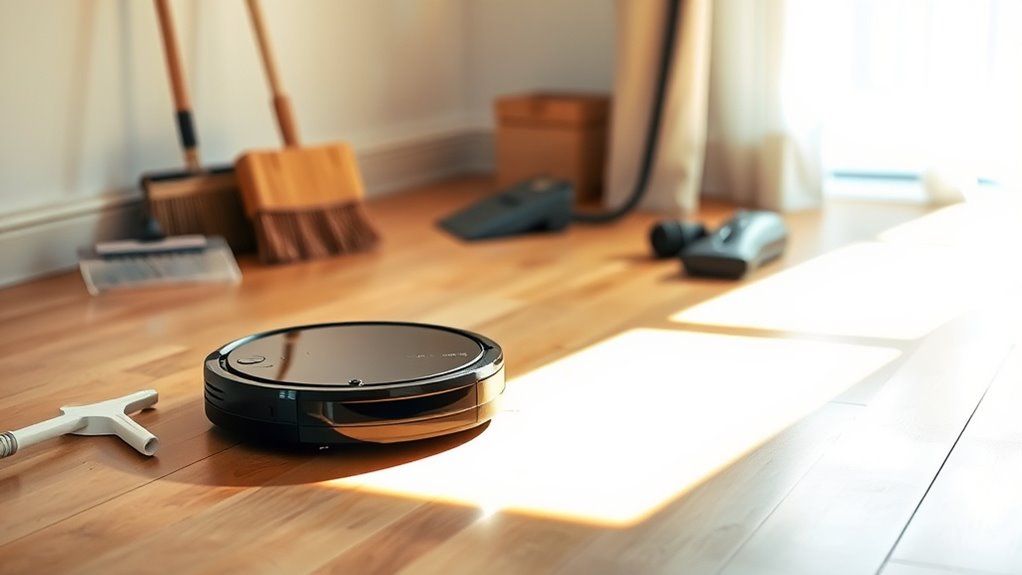
Robot vacuums have changed how many people approach daily cleaning by handling routine tasks with minimal effort, but they haven’t replaced traditional devices entirely. They excel at maintaining hard floors and reducing the frequency of manual vacuuming, especially in busy households. However, their limited suction power means deep cleaning, especially on thick carpets or embedded dirt, still relies on traditional vacuums. Robots often miss debris in corners, edges, and on textured surfaces, making manual tools essential for detailed cleaning. As a result, traditional vacuums remain popular for versatility, upholstery, stairs, and areas robots can’t reach. While robot vacuums shift user habits toward more frequent, less effortful maintenance, they complement rather than eliminate manual cleaning routines. This blend keeps traditional devices relevant despite the rise of automation. Additionally, energy efficiency features in some models help reduce overall operational costs, making them a practical choice for many households. Robot vacuums are less effective for deep cleaning tasks and require manual vacuuming for thorough dirt removal, especially on carpets.
Future Developments and Market Growth Potential
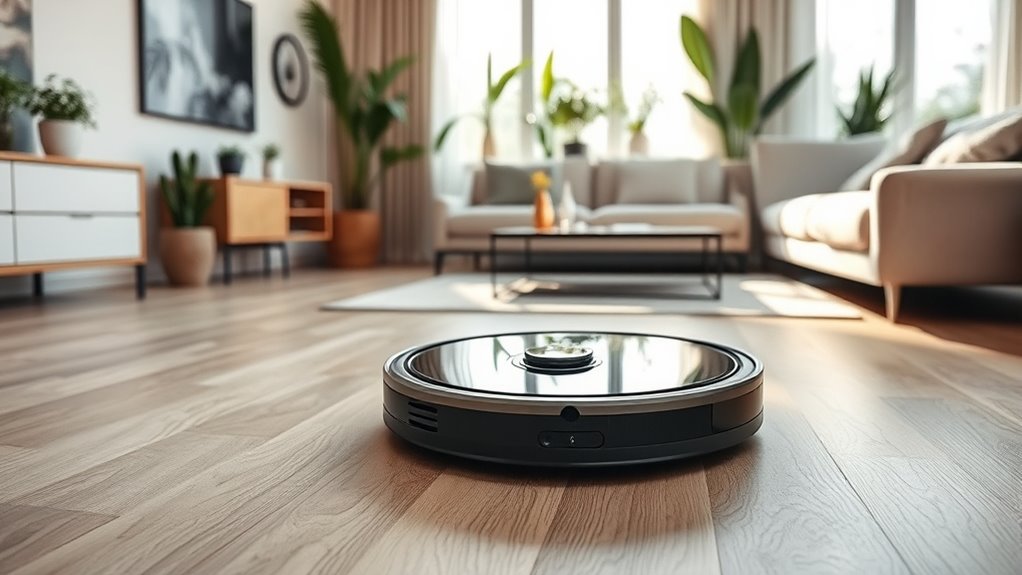
As advancements in technology continue to accelerate, the market for robotic vacuums is poised for significant growth, driven by innovations that enhance efficiency and user convenience. The industry is projected to grow from USD 11.14 billion in 2025 to USD 35.56 billion by 2035, with a CAGR of 12.3%. Innovations like AI-powered navigation, SLAM mapping, and multifunctional cleaning modules improve performance and user experience. Smart sensors, voice compatibility, longer battery life, and app controls make these devices more integrated and customizable. Increased investments, government support, and eco-friendly designs further fuel growth. Market expansion is driven by urbanization, rising incomes, and an aging population seeking easy-to-use cleaning solutions. Future developments include smarter obstacle avoidance, IoT integration, and multi-tasking capabilities, shaping a rapidly evolving industry. Technological advancements continue to be a primary driver, enabling these devices to perform more complex tasks efficiently.
Will Robotic Vacuums Fully Replace Manual Cleaning?

Technological advancements are making robotic vacuums more capable and user-friendly, prompting questions about whether they can fully replace manual cleaning. While they excel at daily light tasks and hard-to-reach areas, they have limitations. Their limited suction power makes deep cleaning difficult, especially on thick carpets or stubborn dirt. They also can get stuck or require frequent maintenance. Their ability to adapt to different surfaces and conditions is continually improving, yet they still struggle with very complex environments.
| Robotic Vacuums | Manual Cleaning |
|---|---|
| Convenient, automated, quiet | Deep, thorough cleaning |
| Access tight spaces, daily use | Handles stubborn dirt and heavy cleaning |
| Limited on heavy-duty tasks | Better control and customization |
While robotic vacuums are great for routine upkeep, they cannot fully replace manual cleaning for deep, intensive tasks.
Frequently Asked Questions
How Long Do Robot Vacuums Typically Last Before Needing Replacement?
Think of your robot vacuum like a trusty sidekick—its lifespan depends on your care. Typically, it lasts around 4 to 6 years, outperforming upright models. You can extend its life by cleaning brushes, updating software, and replacing batteries when needed. With proper maintenance, your robot can keep cleaning efficiently, giving you years of hands-free convenience before it’s time for a replacement.
Are Robotic Vacuums Safe Around Pets and Children?
You can generally trust robotic vacuums to be safe around pets and children if you supervise and set boundaries. They have sensors, rounded edges, and child lock features to prevent injuries and accidents. Keep children and pets away during initial use, use no-go zones, and make sure chemicals are stored securely. Regularly monitor your pets’ reactions, and follow manufacturer instructions for safe operation, making your home a safer space for everyone.
Can Robot Vacuums Clean Stairs or Multi-Level Homes Effectively?
Think of a robot vacuum like a brave explorer trying to conquer uncharted territory. While some models like the Migo Ascender can climb stairs up to 8.7 inches, most still struggle with standard stairs over 2.5 inches high. You’ll find that these devices excel on flat floors, but for multi-level homes, you’ll often need to manually move them or use multiple units. Future tech promises better stair navigation, but for now, manual help remains essential.
What Are the Most Common Maintenance Tasks for Robotic Vacuums?
The most common maintenance tasks for robotic vacuums include emptying the dustbin after each use and cleaning it regularly with water and mild detergent. You should also check and clean the brushes and filters every 2-3 months, and inspect the wheels weekly for hair and debris. Additionally, clean sensors and charging contacts monthly to keep your robot steering smoothly. These simple steps help prolong its lifespan and maintain peak performance.
How Does the Cost of Robotic Vacuums Compare to Traditional Models Long-Term?
When comparing long-term costs, robotic vacuums often save you money on maintenance and energy, thanks to fewer parts and lower power use. However, their higher upfront price and potential battery replacements can add up. Traditional vacuums are cheaper initially but may cost more over time due to ongoing purchases of bags, filters, and repairs. Your choice depends on your cleaning needs, home type, and budget for both initial investment and ongoing expenses.
Conclusion
As robotic vacuums become smarter, faster, and more efficient, they carve a path toward effortless cleanliness. You’ll watch dust and debris disappear without lifting a finger, while your traditional tools gather dust in the closet. With innovation and convenience guiding the way, manual cleaning may become a thing of the past. Embrace the future—where your home stays spotless, and your time is free for what truly matters.
